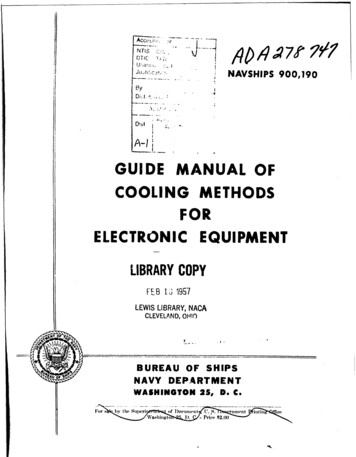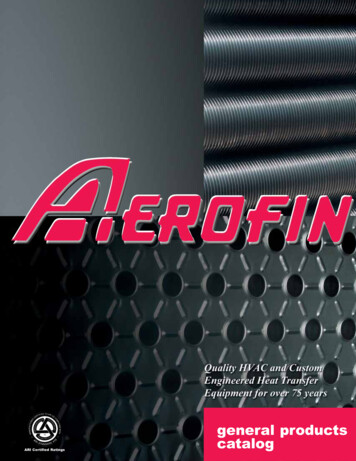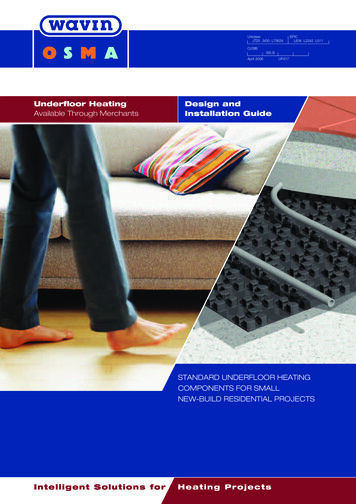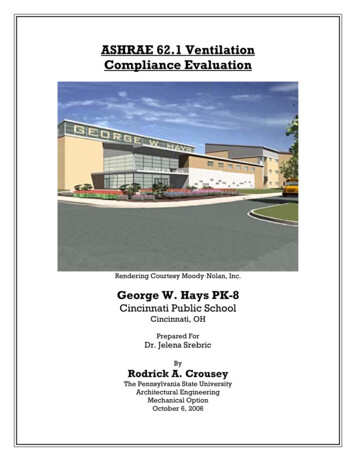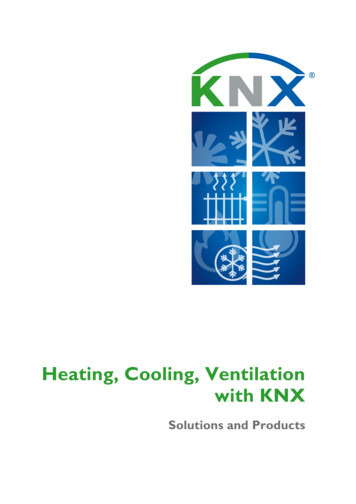
Transcription
Heating, Cooling, Ventilationwith KNXSolutions and Products
EditorialContentsEditorial4Solutions8KNX as a subsystem for price-sensitive solutionsKNX offers interesting solutions as a dedicated climate control system9Only as much as necessary, not as much as possibleDCV solution for demand-based ventilation10Ambient Assisted Living (AAL) with KNXAugmented reality and voice control as most intuitive methods for HVAC interaction11A thinking homeBuderus heating system supplies heat as part of KNX home automation12Optimal air quality in rooms with lots of peopleMore energy efficiency through KNX room temperature controller with CO2 sensor13Office building with high level of comfort and energy savingsControl signal for fan coils offers efficient control and noiseless fan operation14Integration of heating systems into the KNX systemConnection between KNX and heating systems creates new possibilities15New smart buildings on French HAGER production siteIntegration of SAUTER BACnet / IP-KNX controllers and HAGER KNX devices16Climate control in an aesthetically demanding penthouseThe Vitrum touch panel fulfills the high design requirements of the Milanese architect17Energy plus fresh airVallox – smart ventilation for optimal air balance integration18ABB, Arcus-EDS, Astrum, Basalte bvba19Belimo Automation AG, Berker, Bleu Comm Azur SARL, Bosch20Busch-Jaeger Elektro GmbH, Ekinex by SBS, Elsner Elektronik GmbH, Hugo Müller21IDDERO, Insta Elektro GmbH, Intesis, ISE Individuelle Software-Entwicklung GmbH22Albrecht Jung GmbH & Co. KG, Maico Elektroapparate-Fabrik GmbH,MDT Technologies GmbH, Pulsar Engineering SRL23Fr. Sauter AG, Siemens AG, Sinapsi SRL, Stiebel Eltron GmbH & Co. KG24Theben AG, Vallox GmbH, Viessmann Werke GmbH & Co. KG, Vitrum25Weinzierl Engineering GmbH, Wolf GmbHProductsNetworking of the room automation functionsOverview of heating, ventilation and air conditioning systems3
EditorialNetworking of theroom automation functionsOverview of heating, ventilation and air conditioning systems4In addition to classic lighting andsun protection control, applications for heating, ventilation and airconditioning (HVAC) in particularform an essential part of modernroom and building automation. Asa worldwide standard for home andbuilding system technology, KNXalso integrates further applications.Considering that home and building automation accounts for 40 %of the total energy consumption,energy efficiency is paramount aswell as an increase in comfort. Theenergy efficiency of buildings as wellas the influence of building automation is described in the Europeanstandard EN 15232. The methodsdescribed there evaluate the influence of the building automationand the technical building management on the energy consumption.The standard classifies building automation and control systems intofour energy efficiency classes A toD. While efficiency class C only requires the minimum legal standardwithout energy-saving automation,the networking of energy-efficientroom automation functions is necessary for all applications (heating,cooling, ventilation, lighting and sunprotection) and demand-orientedcontrol to achieve class A.KNX offers not only the technicalrequirement for the integration andcommunication of the different applications and products but has already shown in a variety of studiesand projects that savings of 50 % to60 % can be achieved through individual room control and ventilationcontrol alone.Through the networking of sensors, actuators and intelligent controllers via KNX, information anddata can be simultaneously usedin several applications. Presencedetectors for example regulate thelighting not only dependent on daylight but provide the room climatecontrol system and the sun protection system with important information about the occupation of theroom. The previously separate lightup toswitches and room thermostats aremerged into one room controllerwhich can be used to control all thefunctions in a room.The integration of the heating,ventilation and air conditioningtechnology in the home and building automation has long been partof the standard KNX applications.Currently over 70 manufacturershave registered KNX products withheating, ventilation and air conditioning applications with the KNXAssociation. You can find a selection of solutions and products inthis brochure.40%with KNX shutter controlup to50%with KNX single room controlup to60%with KNX lighting controlup to60%with KNX ventilation control
Individual room temperature control offers the possibility of regulating the room temperature of a singleroom regardless of the temperaturein other rooms. To do so, it is however necessary for the temperaturein each room to be measured separately. The current controllers aremainly complete, aesthetically sophisticated room controllers whichare not only used to measure thetemperature and to set values but also to control all the other functionsin a room. Some of the current controllers can also measure the CO2content and air humidity as well assupport the heating and / or coolingoperating modes. Via the networking of sensors and actuators in theroom, the individual room temperature control also offers the optionof including the status of presencedetectors and window contacts andcontrolling the room temperatureautomatically dependent on the respective conditions. In projects thathave already been implemented, energy savings of up to 50 % could beachieved with individual room temperature control based on KNX.EditorialIndividual room temperature control12341 Iddero: KNX 4.3" Touch Panel 2 Berker: KNX room controller with TFT display3 Vitrum: Vitrum Clima Control 4 Basalte: Deseo temperature controller5675 Elsner Elektronik: Cala KNX Room Controller 6 MDT Technologies: Glass push button Smart II7 ABB: ABB i-bus KNX Logic Controller ABA/S 1.2.18910118 Sauter: Room Controller ecos504/505 9 Bleu Comm Azur: realKNX Server10 Siemens: Synco IC 11 Sinapsi: M-Bus/W.M-Bus Web ServerRadiator and underfloor heating, cooling ceilingsIn radiator and underfloor heating,the centrally generated energy istransported with water to the required locations in the building viapumps and piping. Valves controlthe rate of flow in the individualheating circuits and thus the heatemission. Cooling ceilings functionaccording to the same principle, theonly difference being that cooledwater is transported through thepipes and heat is extracted fromthe room via the cooling elements.The triggering of the valves is normally carried out via analogue thermoelectric or motor valve drives.Thermoelectric drives are connected cost-effectively to special KNXactuators which usually have multiple channels. Motor valve driveswith an integrated KNX interfaceon the other hand have the benefitthat the valves can be very preciselypositioned and mostly have additional intelligence and diagnosticfunctions. Through bidirectionalcommunication, it is furthermorepossible to transfer both the current valve position and error messages via KNX.12 Insta Elektro: KNX Valve drive 1B13 Ekinex by SBS: KNX mixing actuator14 MDT Technologies: Heating actuator1213145
Fan coil controllersEditorialThe term “fan coil” means a convector fan which is typically usedfor cooling rooms. Applicationsare also possible in which the fancoil unit is used for heating or ventilation. Traditionally, a fan coil unitcomprises a fan and a heating orcooling register (coil). The centrallyproduced cooling or heating capacity is routed through the building viathe piping system and retrieved byeach unit as required. As a generalrule, one fan coil unit is installed perroom. A benefit of fan coil control is6the rapid availability of thermal energy or cooling capacity. It is therefore widely used in hotels and officebuildings.It is possible via KNX to separatethe unit and the operation cost-effectively in terms of rooms. Thecontrol of the fan and the heatingor cooling register is carried outvia special KNX fan coil actuatorsin the unit while the operation isusually carried out via KNX roomthermostats with extended functions and setting options.1515 Jung:KNX Fan Coil Controller16 Theben:Fan Coil Actuator FCA 2 KNX16Interfaces to energy generation and distribution systemsWith interfaces to energy generation systems such as condensingboilers (oil, gas, zeolite), heat pumpsas well as solar thermal and photovoltaic systems, system operatorshave the option of finding out aboutthe current state of their heatingsystem using the KNX visualisationsystem, predefining setpoint valuesand setting operating modes. Faultsignals are automatically transmitted to KNX and displayed so thatthe appropriate measuresSolar modulecan beSM-2taken before any damageoccurs.As the current heat requirement inthe rooms can be communicatedin most cases via the KNX gateway to the heating controllers, theheat generation must be preciselymatched to the current demand.Ethernet/KNXinterface17171819Internal20bus system21EthernetISM8 – eBus/EthernetinterfaceGas condensing boilerCGB-217 ISE Individuelle Software-Entwicklung: ise smart connect KNX Vaillant 18 Viessmann: Vitogate 20019 Stiebel Eltron: Internet-Service-Gateway (ISG) 20 Bosch: Bosch Gateway KNX 10 21 Wolf: Wolf KNX interface kitDomestic ventilation unitCWL-ExcellentVariable volume flow controllerWith the variable volume flow controller (VAV), a centrally producedair flow is routed to the rooms andareas in which the air conditioning is regulated. The control of theamount of air and heat is carried outvia flaps in the piping system. In mostcases, the variable volume flow conSchaubild CDebera ENG.indd 1troller is decentralised and installedseparately for each room so thatonly the required amount of energyis used to maintain the respectiveindoor room climate. Based on therecorded room conditions and thecurrent air requirement, energetically intelligent and demand-con-trolled systems can be set up withKNX. A central control unit permanently monitors the flap positions ofthe individual VAV boxes via KNX.If the flaps destroy excessive inletpressure, this is reduced. It is theaim to operate the system with thelowest possible pressure loss.15.12.16 14:1822 Belimo Automation: VAV controller and actuators23 Maico: KNX ventilation units with HR2223
To minimise the energy losses, newbuildings are built increasingly airtight. If the natural ventilation nolonger exists due to the design, monitored ventilation and extraction isrequired as otherwise consequentialdamage to people and buildings mayarise and the occurrence of mould,spores and bacteria may be encouraged. When using automated ventilation, additional parameters such asthe maintenance of limit values forthe CO2 content, the air humidityand the room temperature are taken2425into account. With active monitoredventilation and extraction, a centralventilation unit blows fresh air intothe building/rooms. On the roomside, the “consumed” air is extracted and discharged. With the optional heat recovery, the thermal energyis extracted from the discharged aire.g. via a cross-flow heat exchangerin order to warm up the “fresh” airwith it. With this process, heat exchangers inside a building such aslighting, computers etc. can also beused for heating which contributes26to an increase in energy savings. Inaddition to the baseline values, thevalues for the room temperature, airhumidity and carbon dioxide contentmeasured by the KNX individualroom controllers and air quality sensors can be transferred via the KNXinterfaces to the ventilation systemand taken into account during thecontrol. In the other direction, theventilation system transfers statussignals to KNX which for examplesignal the necessary replacement ofventilation filters.24 arcus-eds: KNX LUNOS-CONTROL425 Busch-Jaeger: KNX room temperature controllerwith CO2 sensor26 Hugo Müller: KNX air quality sensor27 Vallox: VALLOX MV KNX bus module27Interfaces to distributed air conditioning systemsDistributed air conditioning systems with split or monobloc devices form an individual concept forflexible room usage. In the case ofsplit devices, the compression ofthe refrigerant is carried out outsidewhile the air delivery, filtering andtemperature control is carried outin the room that is to be cooled. In282930the case of monobloc devices, all thecomponents are located in a singledevice indoors. The disadvantageis that the compressor is located inthe room and represents a considerable source of noise compared toa split device. Moreover an exhausthose is required to carry the warmair outside. The interfaces to the air31conditioning systems are versatile.In addition to a few standardisedinterfaces, the manufacturers use avariety of proprietary hardware andprotocol solutions. In spite of thevariety of interfaces, special KNXgateways enable the integration ofalmost all the air conditioning devices into KNX.28 Weinzierl Engineering: KNX Modbus Gateway 88629 Astrum: VFACE – Ultimate VRF Interface30 Pulsar: THINKNX BRICKBOX31 Intesis: IntesisBox Universal KNX AC GatewaySummaryAs regards products, planners andinstallers can choose from over7,000 certified KNX products whichcover all the applications of heating, ventilation and air condition-ing. The KNX worldwide standardthus offers the best requirementsto improve the energy efficiency ofbuildings. In particular, the integralnetworking of energy-efficiencyroom automation functions of allthe trades and demand-based control contribute significantly to energy savings in buildings.EditorialRoom air control and interfaces to ventilation systems7
KNX as a subsystemfor price-sensitive solutionsSolutionsKNX offers interesting solutionsas a dedicated climate control system8ARCUS-EDS GMBH Berlin Lichtenberg: This is a multiplefamily house with ten housing units. At an early decisionstage the builder decided not to implement a KNX installation. The reason was the cost. The higher level ofcomfort would have been put on the rent and this wasnot wanted.The situation changed partly during the course of theengineering planning. Due to KFW funding according toKFW70, ventilation with heat recovery was necessary inorder to meet the KFW70 energy standard. The goodthermal insulation and the air-tight outer shell of thebuilding also incurred the risk of damage due to damp.The ventilation should therefore also be controlled bymoisture and the room temperature in each room controlled separately. In this case, a conventional installation had no advantages compared to a KNX solution.The KNX installation was designed as a separate ventilation and heating installation. The power supply comesfrom one 24 – 32 V DC supply per flat, using the auxiliaryvoltage wires. A separate power installation for the fanand valve controls was therefore omitted. The fans arecontrolled via “KNX-Lunos-Control4”. The temperature control is carried out per room via room temperature controller “SK30-THC-CO2-PB”, on which the fanspeeds can also be set individually. The control of the24 V valves of the floor heating system is implementedvia “KNX-Ventil4” devices and the basic settings of thetemperature and ventilation profiles are displayed on a3.5" visualisation panel “Touch-IT Smart”. We thus havea compact KNX system with comparable costs to othersolutions.Even if the basic installation is carried out in a conventional manner, the possibility of making use of thestrengths of the KNX system can be found in housingconstruction. The user reactions are very positive.Some parties have already shown interest in extending the possibilities of the KNX installation for remotemaintenance and Internet networking.Contact: www.arcus-eds.deA LUNOS e2 Set B RA 15-60 Exhaust C Touch-IT / C3 / Smart / NEO D Sensors: temperature, humidity, CO2, SK30-THC-CO2 / NEO-THC-CO2 / E Various switch systems
Only as much as necessary,not as much as possibleBELIMO AUTOMATION AG The DCV technology (Demand Controlled Ventilation) measures the conditionsin a room and calculates the amount of air actually required. It is applied to regulate the fans according to thedemand. Devices used are sensors and control devicesfor CO2, VOC, temperature and so on. The required airvolume is supplied to the room by precise volumetricflow controllers.Performance adjustment of the fans viathe ventilation system’s actual demandEfficient fan control is a vital part of a DCV system. Nextto variable speed drive-controlled fans, EC fans are increasingly being implemented. To adapt the fan powermade available to the ventilation system, the DCV system must gauge the ventilation system’s requirementsand set a suitable setpoint.In a pressure feedback Fan Optimiser system, only asmuch pressure as required is produced to transport thecurrent volume through the air duct system. The goal isto operate the system with the least pressure loss.The Fan Optimiser function permanently monitors thedamper positions of each VAV box. If the dampers eliminate the surplus of supply pressure, this pressure willbe lowered – in contrast to the pressure-controlled systems where the supply pressure corresponds to the fullload operation and thus not as much as possible.System design of a pressure feedbackFan Optimiser systemIf the system is configured as a bus system, or if a bussystem is already installed, then there are basically noadditional hardware costs. The volumetric flow controllers VAV-Compact KNX are integrated via KNXTP and the damper blade positions are evaluated by theFan Optimiser application. The optimisation is calculated separately for supply and extract air and requires anopening angle of 80 – 90 %.Operating points on the fan characteristicsBus-capable volumetric flowcontroller VAV-CompactSolutionsDCV solution for demand-based ventilationPotential savings – Case studyFor a comparison in an office building the Fan Optimiserapplication was programmed into a DDC controller. TheVAV controllers are connected to the DDC controllerby bus communication. In addition to the Fan Optimiser,the system also has a conventional duct pressure control for taking comparative measurements. Either control function can be selected in order to compare thetwo strategies under identical operating conditions.The measured current difference on the chosen day wasan impressive saving of 64 %. Over the course of a yearthe savings would probably lie between 20 % and 50 %,depending on the system and the partial load conditions.Fields of application VAV system in office buildings, hotels, hospitals, etc. Variable volume systems for controlled residentialventilationBenefits of a Fan Optimiser system Compliant with EN 15232, Class ANo reduction in comfortCompensates for design errorsEasy commissioning, finds its own operating point automatically Energy-optimised, minimal pressure loss Reduced noise, thanks to lower duct pressure Short payback time, low operating costsContact: www.belimo.euDesign of a Fan Optimiser application9
Ambient Assisted Living (AAL)with KNXSolutionsAugmented reality and voice controlas most intuitive methods for HVAC interaction10A private villa in Eze (France): complete HVAC control with KNXcomponents, configured exclusively with ETSBLEU COMM AZUR SARL KNX allows the control oflighting, media, shutter and shading devices especiallythe integration of all types of HVAC functions in thehome automation environment.In the early days of KNX, some expensive and complicated software was needed to visualise the heating,cooling and electrical circuits. Today there are more intuitive ways to control the installed HVAC system. Oneof the most common ways is the use of smart phonesand tablets. Already in 2012 it was possible to configurethe whole smartphone user interface in ETS softwareusing KNX proServ from Bleu Comm Azur. Independent of the screen resolution and operating system, thebest display results are achieved with the iKnix apps. Thesame KNX proServ (product and ETS configuration)Siri voice control: An extremely intuitive user interface is vocallyand visually answering spoken requestsmay now be used as the basis for even more powerfuland intuitive control together with the new realKNXminiserver. The most impressive way is certainly usingaugmented reality. Actual values, setpoints and textsare shown by pointing with the smartphone camerato the object that has to be examined. Directly in thepicture of the camera the messages are shown, or thebuttons or sliders will appear to allow interaction. Thelinks of web pages become accessible with even moreinformation just by pointing the camera to a gauge, acontrol button or a regulator. Text information aboutstates or critical situations are shown and parametersof heating and climate systems may be edited. Anothermethod of intuitive control is using speech recognition.A very advanced development today is the world of “SIRI”, which understands more than 40 languages and is arising trend. Ask Siri about states, values or let her (orhim) change parameters. No need to touch the phone,the pad or the watch – just say: “Hey Siri” and continuewith your question or command. Siri is even capable ofexamining semantic contexts. You start to ask about thetemperature in the living room, and then continue withother commands without specifying the room, as Siriremembers what you have been talking about. In theSouth of France, an exceptional villa has been equippedwith these techniques. The heating and cooling system isbased on a reversing heating pump, that acts on invisiblefan coil units in every room. In winter time, the underfloor heating will guarantee a stable basic temperatureand the fan coil will allow a fast temperature change ifnecessary. In summer, the fan coil units will work forcooling purposes. The residents are not interested intechniques. They just define a comfortable temperature according to the season. The room controllerscome with a smart user interface from Elsner Elektronik (Corlo Touch) and are the size of a standard switch.They allow the control of lights, move the curtains, startmusic playlists and adjust the temperature. Additionallyand completely intuitively all these functions are available on the smartphone app from iKnix. The augmentedreality and HomeKit speech recognition functionalityhave been included with the standard software on therealKNX server by Bleu Comm Azur. All devices arecompletely configured in the ETS software, no export ofdata to third party software is necessary! The realKNXembedded miniserver works as a blackbox – and interacts directly as a bridge between KNX proServ andHomeKit.Contact: www.proknx.com
A thinking homeBOSCH THERMOTECHNIK GMBH The home of Ute andMatthias Schmidt from Coburg (Germany) is unlike anyother. Thanks to modern KNX standard home automation technology, their house “thinks” and acts automatically – the blinds close when they switch on the TV, theletterbox informs them when the post has been delivered and the socket with an iron plugged in switches offwhen nobody is in the room. This high level of comfortin the “smarthouse213” is increased even further by aBuderus heating system that is integrated into the homeautomation system and now also meets the design andtechnology standards of the house thanks to its new heatgenerator.A new wall-mounted Logamax plus GB182i gas condensing boiler from the Buderus Titanium Line is at the heartof the heating system. It features a glass front, touch paneland Logamatic RC300 controller with EMS plus controlsystem. The heating system is integrated into the homeautomation system via the Logamatic web KM200 Internet gateway on the one hand, connecting it to the LANnetwork. This allows Ute and Matthias to control theirheating system and monitor the system parameters using the Buderus EasyControl app on their smartphoneor tablet computer. The heating system is connected tothe KNX bus via the KNX 10 gateway; in this way, it isconnected not only to the control elements but also toall other components of the building technology system.The line-based KNX building system bus is a global building automation standard. The KNX bus allows a virtuallyunlimited number of components such as heating, light,blinds, window contacts or weather station to be connected and centrally controlled. This reduces the cablingas the components are connected only to the KNX busand information can be used for multiple purposes. KNXallows, for instance, the window contacts to be connected to the single-room control unit of the heating system.When open windows are detected, the room temperature control unit receives this information, switches tofrost protection mode and closes the radiator valves. TheBuderus heat generator is informed that no heat is needed and stops heating. This means that the heating systemsupplies energy only when it is actually needed.The single-room control unit allows Ute and Matthias toset the desired temperatures for individual rooms manually. The fact that the heating system supplies heat as required independently of the outside temperature, helpssave energy. “Requirement-based heating works betterwith KNX 10 than before, as the valve position of theradiators and the exact room temperature are now re-SolutionsBuderus heating system supplies heat aspart of KNX home automation11“smarthouse213” in Coburg was built in 2001.All photos from: vor-ort-foto.de/Henning Rosenbuschported to the heat generator. The actual temperaturecan thus be compared with the desired temperature andthe boiler ‘knows’ whether it should heat or not,” Matthias Schmidt explains.The home server on the ground floor serves as the central operation interface. The touch-screen computer allows Ute and Matthias to keep an eye on all componentsand settings and to adjust them at all times. Wheneverthey change a setting using for example the Buderus AppEasyControl, the system transmits the information to thehome server. But this is required very rarely: “The systemresponds to the information on the KNX bus, e.g. fromthe single-room control unit, the weather station or thewindow contacts and supplies heat whenever it is needed,” says Matthias Schmidt. Apart from the home server,the four operating panels in the house or the RC300 control unit in the cellar may be used to control the buildingtechnology and the heating system. “The house turnedout exactly the way we wanted it,” says Ute Schmidt.Contact: www.buderus.deThe home server is thecentral operation interfaceMatthias Schmidt usesKNX and EasyControl
Optimal air quality in roomswith lots of peopleMore energy efficiency throughKNX room temperature controller with CO2 sensorSolutionsRoom temperature controller usedin the f u t u r e linear switch range.12Optimal air quality in large rooms.Photos: Busch-JaegerBUSCH-JAEGER ELEKTRO GMBH Modern new buildshave good thermal insulation thanks to energy-savinglegislation. This insulation of windows, roofs and wallsleads to very low air exchange values, with the benefit that energy is saved, but with the disadvantage ofincreased CO2 concentrations indoors, alongside increased air humidity. That’s why it is all the more important to control the fresh air supply as needed. The KNXroom temperature controller with CO2 sensor offersthe optional solution.Carbon dioxide is an odourless, tasteless gas. Especiallyin areas where lots of people convene, such as meeting rooms, conference rooms and classrooms, the carbon dioxide concentration in the air should not exceed1,000 ppm. A CO2 level of 400 ppm is normal for fresh,natural air outdoors. Concentrations below 1,000 ppmare harmless and require no corrective action. Precautions such as ventilating an area only need to be carriedout when the level reaches a value between 1,000 and2,000 ppm. At that point the air begins to feel stuffy andunpleasant. If the CO2 level rises above 2,000 ppm, thearea must be ventilated significantly and further measures must be looked into for the future.An ideal KNX room temperature controller not onlymeasures the temperature but also the air humidity,the carbon dioxide concentrations in the air and theair pressure. The CO2 concentration depends on theair pressure, which in turn is determined by varyingweather conditions (low and high pressure), changes inthe altitude of the measuring location (meters above sealevel), and also air flows. It is therefore important thatthe air pressure be taken into account when measuringconcentrations of carbon dioxide in the air.With KNX room climate control, it is precisely thesefactors (temperature, CO2, air pressure and air humidity) that are recorded and controlled. Data for airquality and room temperature control are provided tothe KNX bus. This data can be both visualised and usedto control the heating and ventilation systems throughupper and lower limits for the measured values. Thismeans that, for example, if the CO2 concentration is toohigh, ventilators in the room can be switched on or windows opened automatically. The quality of the air in theroom is constantly recorded and monitored. No manualaction is required thanks to the automation. This roomclimate control system is often used in high-traffic areaswhere the number of people frequently varies, such asin consumer markets, shopping centres, hotels, cinemas, theatres, hospitals and schools.The figures show how important it is to have a goodindoor environment: Europeans spend on average90 percent of their time indoors – at home, at work,or in vehicles (car, bus, train). Indoor air plays an evenbigger role in our health than outdoor air, which is oftencited as a source of problems. For this reason, the airindoors should not be polluted with harmful substances.Good indoor air quality supports healthy well-being.In purpose-built installations, the KNX room temperature controller with CO2 sensor provides maximum energy efficiency, but keep in mind that detailed planningwith a competent specialist is necessary.Contact: www.BUSCH-JAEGER.de
Office building with high level ofcomfort and energy savingsEKINEX Fan
The Vitrum touch panel fulfills the high design requirements of the Milanese architect 17 Energy plus fresh air . cooling, ventilation, lighting and sun protection) and demand-oriented control to achieve class A. KNX offers not only the technical . KNX LUNOS-CONTROL4 25 Busch



